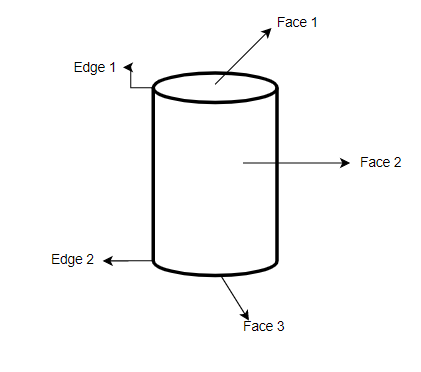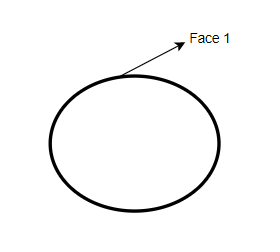
How many faces, edges, and vertices are there in the following figures?
$\left( a \right){\text{ Cylinder}}$
$\left( b \right){\text{ Sphere}}$
Answer
555.3k+ views
Hint: This type of problem can be solved by seeing the figure and knowing the terms which we have to find. So for the vertices, there should be a corner and for the edge, there should be a straight line and for the face, there should be surfaces. By using all this now we are able to answer this question.
Complete step-by-step answer:
$\left( a \right){\text{ Cylinder}}$

Here from the figure, we can see that there are two straight lines and three surfaces can be seen and also there should be a corner for the vertex. Therefore, in a cylinder, there will be three faces and two edges, and zero vertices.
$\left( b \right){\text{ Sphere}}$

Here from the figure, we can see that there is no straight line and one surface can be seen and also there should be a corner for the vertex. Therefore, in a sphere, there will be one face and zero edges, and zero vertices.
Additional information:
A vertex in a mathematical figure can be characterized as a corner. A point where at least two line fragments meet is known as a vertex. A line portion between faces is known as an edge. A solitary level surface is known as a face. For instance, a tetrahedron has $4$ vertices and a pentagon has $5$ vertices. Vertices are the plural form of the vertex.
Note: So we have seen that if we know the shapes and figures then very easily we can answer this type of question. We just have to know the meaning of each type and their properties then we can easily tell the number of faces, vertices, or edges.
Complete step-by-step answer:
$\left( a \right){\text{ Cylinder}}$

Here from the figure, we can see that there are two straight lines and three surfaces can be seen and also there should be a corner for the vertex. Therefore, in a cylinder, there will be three faces and two edges, and zero vertices.
$\left( b \right){\text{ Sphere}}$

Here from the figure, we can see that there is no straight line and one surface can be seen and also there should be a corner for the vertex. Therefore, in a sphere, there will be one face and zero edges, and zero vertices.
Additional information:
A vertex in a mathematical figure can be characterized as a corner. A point where at least two line fragments meet is known as a vertex. A line portion between faces is known as an edge. A solitary level surface is known as a face. For instance, a tetrahedron has $4$ vertices and a pentagon has $5$ vertices. Vertices are the plural form of the vertex.
Note: So we have seen that if we know the shapes and figures then very easily we can answer this type of question. We just have to know the meaning of each type and their properties then we can easily tell the number of faces, vertices, or edges.
Recently Updated Pages
Master Class 8 Maths: Engaging Questions & Answers for Success

Class 8 Question and Answer - Your Ultimate Solutions Guide

Master Class 12 Economics: Engaging Questions & Answers for Success

Master Class 12 Maths: Engaging Questions & Answers for Success

Master Class 12 Biology: Engaging Questions & Answers for Success

Master Class 12 Physics: Engaging Questions & Answers for Success

Trending doubts
What is BLO What is the full form of BLO class 8 social science CBSE

Which one of the following groups comprises states class 8 social science CBSE

Citizens of India can vote at the age of A 18 years class 8 social science CBSE

Full form of STD, ISD and PCO

A couple went for a picnic They have 5 sons and each class 8 maths CBSE

Right to vote is a AFundamental Right BFundamental class 8 social science CBSE




